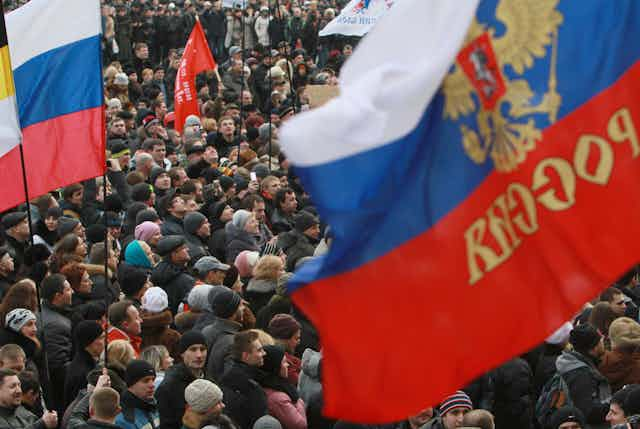A tense evening in Donetsk. Around 1,000 pro-Russian supporters gathered in front of the building which houses both the regional state administration and the regional council late on Wednesday afternoon. With pro-Ukrainian groups also taking to the streets, order sometimes seems to be hanging by a thread here.
It is important to understand that the movement to separate from Ukraine probably represents a small minority of popular opinion in the region. The majority of people in Donetsk, as well the region’s commercial and political elite, are supporting forces which proclaim a strong and united Ukraine. But as the political standoff continues over the fate of Ukraine and its regions, it’s never quite clear where the momentum lies.
On Tuesday, around 1,500 anti-separatist, pro-Ukrainian protesters gathered outside the newly built Russian orthodox cathedral in central Donetsk. The crowd, comprised of the young, educated middle class, waved Ukrainian flags and sang the national anthem. With the exception of when the Ukrainian national football team played in Donetsk during the Euro 2012 championships this was the first significant expression I have seen of popular support for Ukraine and the unity of the country.
It’s also notable that the pro-Ukraine protest, a direct reaction to the pro-Russian movement, was spontaneously organised through social media. Contrast that with the Soviet-era music played on Wednesday to liven up the mainly elderly, relatively less-educated crowd.
The government building where they gathered was well protected by ordinary police as well as riot police in helmets and with metal shields. There was also at least one group of so-called Titushky keeping an eye on events from a distance.
A self-styled ruler
Some demonstrators waved Russian and even Soviet flags. The crowd was then addressed by Pavel Gubarev the self-styled leader of the “Donbass self-defence movement” and the “Patriotic Forces of the Donbass” which has emerged in the days since the fall of Viktor Yanukovych. He regards himself as the “people’s governor” of Donbass – the wider region Donetsk lies in, which borders Russia.
Gubarev demands a referendum on the status of the Donbass within Ukraine. Even that is fraught with complexity. Some protesters seek federalisation with Ukraine which some argue would be the first step to the division of the country. Others seek independent status whilst still others wish the Donbass to join Russia. Gubarev also denounced Serhiy Taruta the new regional governor and local business tycoon who has been appointed by the interim president in Kiev and has a similar view on the new head of the regional council Andrey Shishatsky who was the governor under former president Yanukovych but who has expressed loyalty to the new authorities in Kiev.
So far, the sides haven’t come to blows, but Gubarev has been urging the crowd to disrupt another planned anti-separatism demonstration scheduled to take place in the city’s central square, and he characterises the anti-separatist pro-Ukrainians as ultra-nationalists or neo-fascists. It won’t be lost on anyone that the heart of the action is named Lenin Square and is dominated by a large statue of the revolutionary leader.
There is speculation in the town that elements of the militia may be sympathetic to the pro-Russian movement. And it was notable that after a speech in which Gubarev had urged the crowd to recapture the government building from which they had been expelled by the militia earlier today, the militia withdrew and the demonstrators began to attack and enter the government building once again. As the demonstration broke up, around 1,000 protestors marched to the central covered market.
The political grandstanding amid swirls of protestors can disguise the fact that the demonstrations so far have been relatively small. The overwhelming majority of people are carrying on going to work, school or university; playing with their kids or grabbing some lunch. Normal life is going on pretty much unhindered.
The fear is that normal life will get a shock if the two sides should meet amid the hyperbole and building tension.

